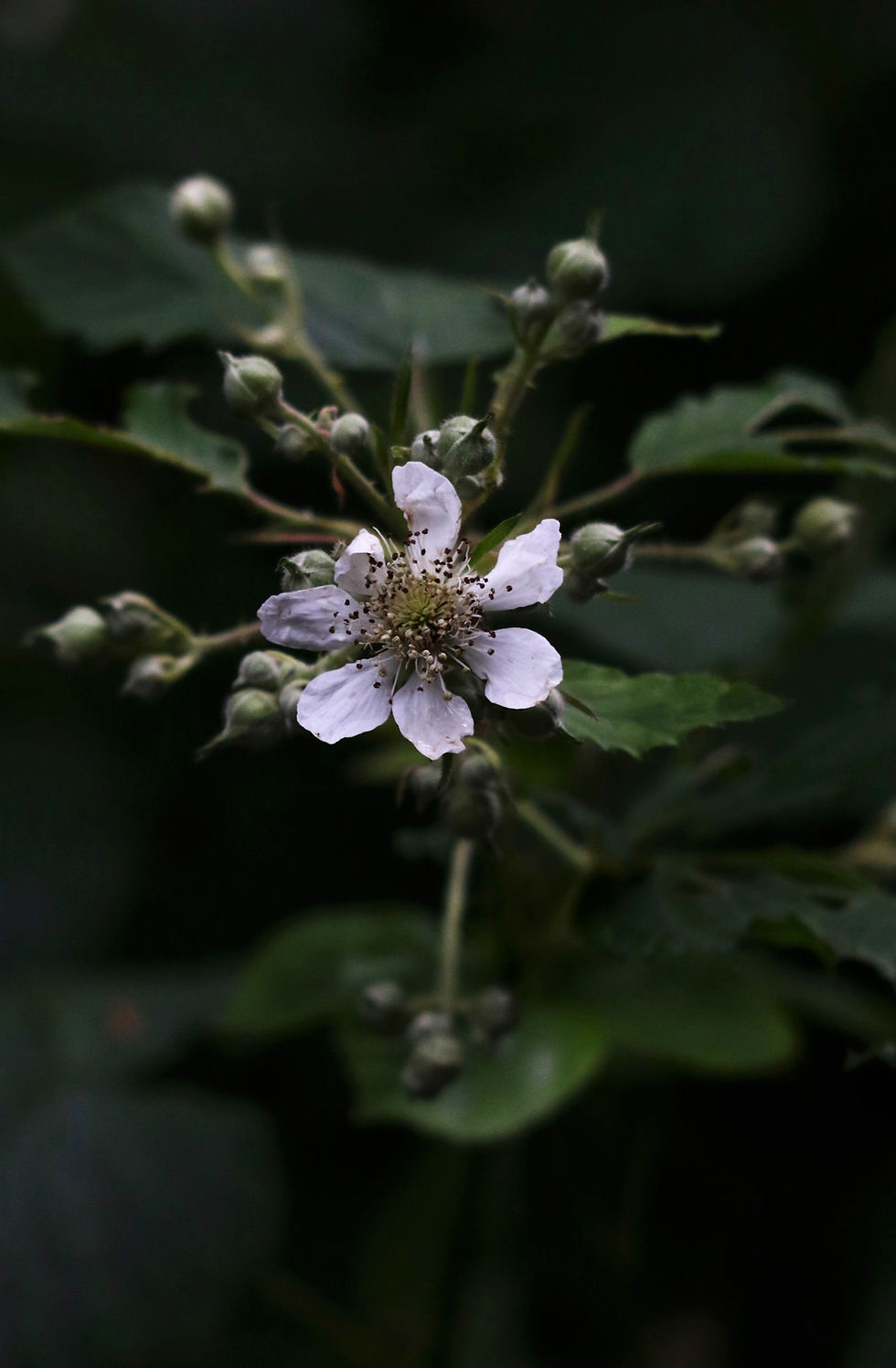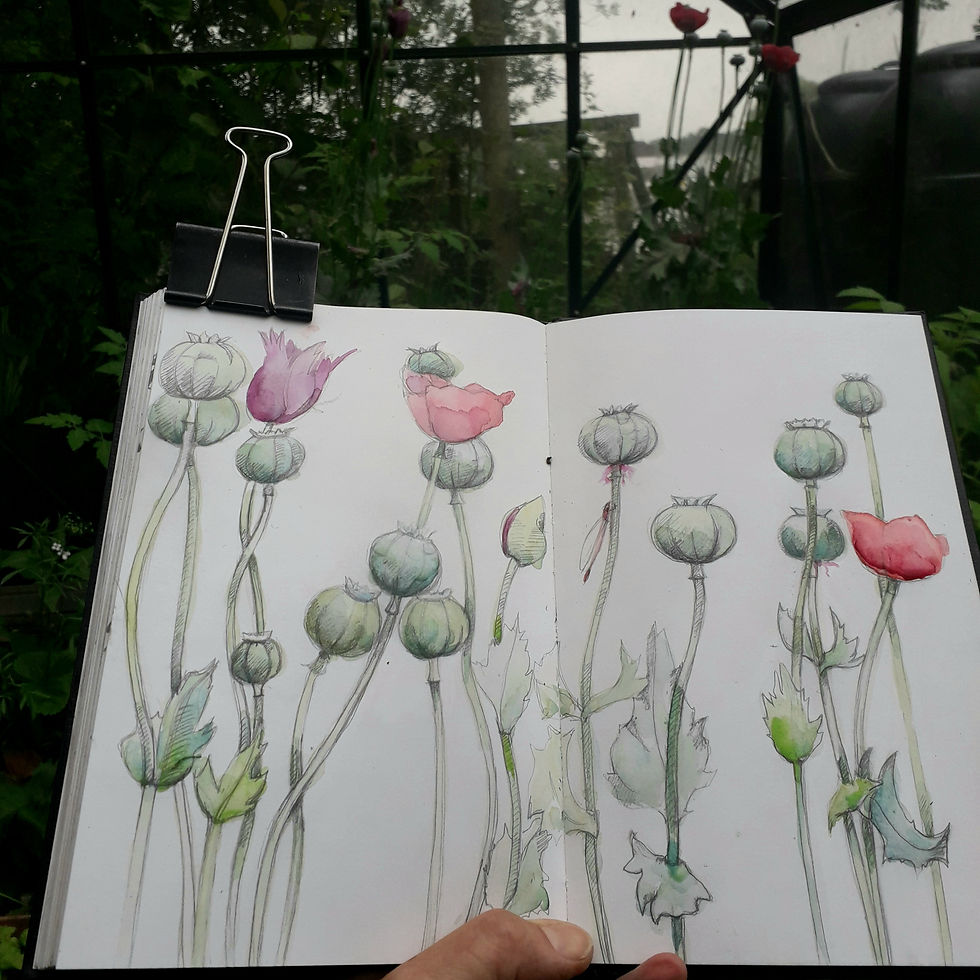Seeking the Overlooked: Woodbine, Rose and Bramble
- Painter and Printmaker
- Jun 16, 2020
- 3 min read
Updated: May 24, 2022

For the first time since early February, I have returned to walk at my beloved Redgrave fen. Throughout these long weeks of lockdown, I have found myself dreaming of the place. When I was last there, the trees were bare and I remember noting the first leaves emerging on honeysuckle, or woodbine, and thinking that the pleasures of Spring were not too far away. It now seems a very long time ago.

Now the hedgerows are festooned with honeysuckle, generously draping itself over sapling trees and filling the pathways with its pale golden crowns. Bees love it by day and by evening, when the scent swells, moths can detect it from a quarter of a mile away. It is especially favoured by the Elephant Hawk moth, with its shocking pink and olive wings, and as dusk falls it flits among the blooms.

I brought hedgerow snippings home to draw, placing them in jam jars, from the tight fingers of buds to the open crowns. It is fiendishly difficult to draw as the structure is tricky to grasp. Each finger opens over a succession of days, enabling the moths to pollinate each in turn, they then turn down and wither before more open the next night for when the moths return.

Still unsure as to how I was going to develop my drawings into a print, I decided to make a small linoprint showing the twining habit with a central flower. I also wanted to make something small to enable me to work out how to simplify these complicated flowers and so this little card was made.

It then seemed that the honeysuckle should be joined by its hedgerow companion, the Dog Rose, another scrambling plant whose soft shell pink flowers last only briefly. Our National flower, they are such a simple form compared to our cultivated varieties, but are no less beautiful for that. There is something especially affecting about their fragility and the way in which they petal bowls hold the sunlight. I have been drawing a plant that edges my garden. It is one that I have never noticed before, although it must have been there, and I have sat drawing it in situ in the shade of the trees.


The brevity of the flower, as well as their beauty, has been noted down the centuries, from the Book of Soloman:
“Let us crown ourselves with rosebuds, before they be withered".
To the poignant verse by Robert Herrick (1591-1674) :
" Gather ye rose-buds while ye may,
Old Time is still a-flying;
And this same flower that smiles today
Tomorrow will be dying."
They have come to symbolise life's fragility and the importance of making the most of the time we have. And so, I felt it was the perfect flower for this time. I hope again to create a small version first, in a small roundel, to use a second midsummer card design.

My last unruly plant, the Bramble, or Blackberry, has been much cursed by me over the years in the garden with its deep, penetrating roots and its vicious thorns, but seeing it this year in the hedgerow at the fen made me see it afresh.
It is another entangling plant, and once established provides impenetrable cover and creates a rich habitat for insects and birds. In ancient times it was planted over graves, seemingly to keep the dead in and the Devil out. It would certainly be a brave devil who tried to fight through a Bramble patch. In combination with the wild rose, both plants came to be known as “lawyers” because of the difficult in extricating yourself if you became entwined in their clutches![1]

I love their arching habit, but when drawing my jam jar snippet, it was the delicacy of the purple flushed papery flowers, and round buds, that attracted me along with the wriggly stamens once the petals have dropped. I was also amazed to discover that in addition to the thorns that snarl along its stem, it also has claws on the back of the leaf mid - rib. It is a plant intent on ensnaring.
The aim is to create a ring of these three plants as a linoprint as both a celebration of midsummer, and of their tenaciousness, a symbol of these strange times. Sometimes such things don’t work out, and with time pressing and their flowering coming to an end, it will be a challenge to complete. But whatever the outcome, I promise to show you here in my next post.
Over on Instagram, I have created a new hashtag called #seekingtheoverlooked in celebration of those plants and creatures whose virtues and beauty are easily missed. Do have a look and join in!
[1] Flora Britannica, Richard Mabey.




Comments